Sights
“Discover Komotini, the Multicultural Heart of Thrace”
- Sights
- Historic Buildings
- Religious Tourism
- Νature Τourism
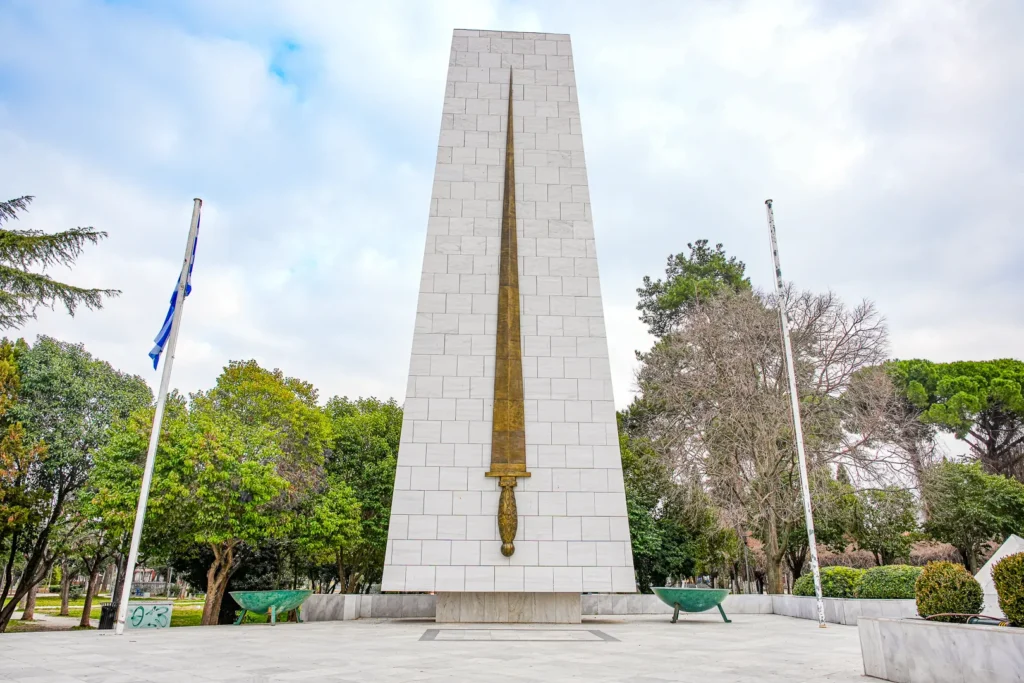
The Central Memorial (Sword)
The Central Memorial, also known as the “Sword,” is one of the most recognizable monuments of Komotini, located in the heart of the city at Eirini Square. This imposing monument was created to honor the heroes who sacrificed their lives for the freedom and independence of the region, symbolizing the bravery and resilience of the people of Thrace. At the base of the monument, the names of the fallen are inscribed, while the sword itself, rising toward the sky, signifies the indomitable will for freedom. The Central Memorial is a landmark and a pilgrimage site for the residents and visitors of Komotini, especially on national holidays, when official ceremonies of honor and remembrance are held.
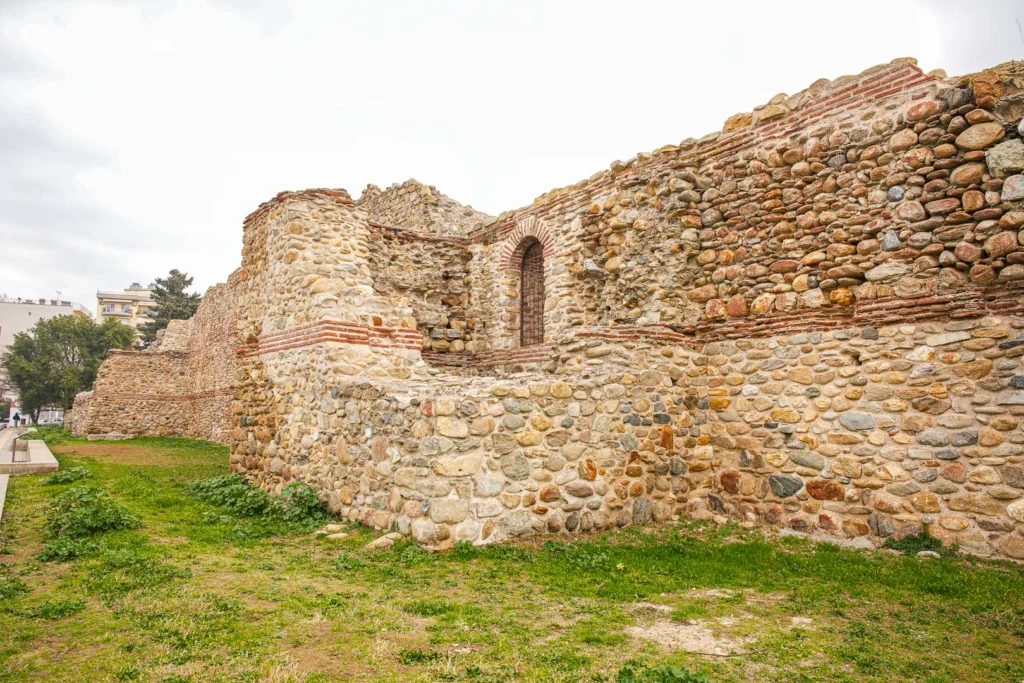
Komotini Fortress and Byzantine Wall
The Fortress and Byzantine Wall of Komotini are significant historical monuments that testify to the city’s long history and strategic importance during the Byzantine period. Built in the 4th century AD under Emperor Theodosius I, the wall once surrounded the old settlement of Komotini, protecting it from raids and sieges. Over the centuries, the city expanded beyond the walls, but the remnants, which include impressive towers and gates, have been preserved as vital elements of the local cultural heritage. Today, visitors can see sections of the wall scattered throughout the old town, serving as a reminder of Komotini’s historic identity and its role as a fortified city in an era when protection and fortifications were essential for the survival of communities.
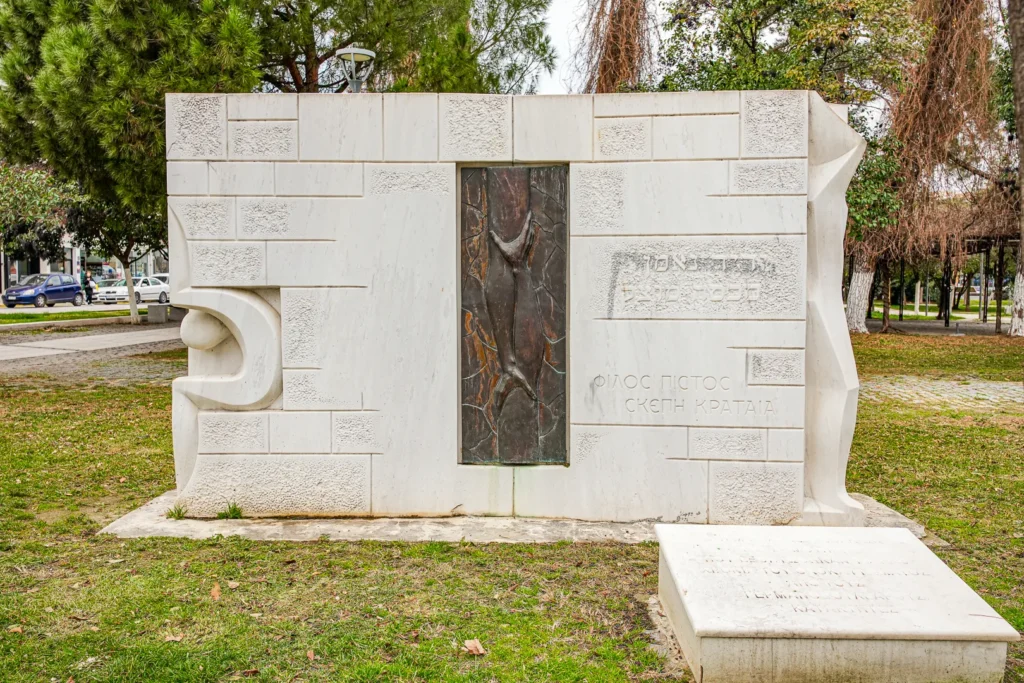
Komotini Jewish Memorial
The Komotini Jewish Memorial is an important site of historical remembrance, dedicated to the Jewish residents of the city who perished during the Holocaust. Located in the central square of Komotini, it was erected in 2004 to honor the Jewish community, which was a vital part of the local society for centuries before it was destroyed during the Occupation. It is a symbolic place of reflection and respect, which recalls the contribution of the Jewish community to the city’s culture and economy, as well as its tragic fate. With a simple yet moving design, the memorial serves not only as a reminder of the past but also as a lasting symbol of the need to prevent similar tragedies in the future.
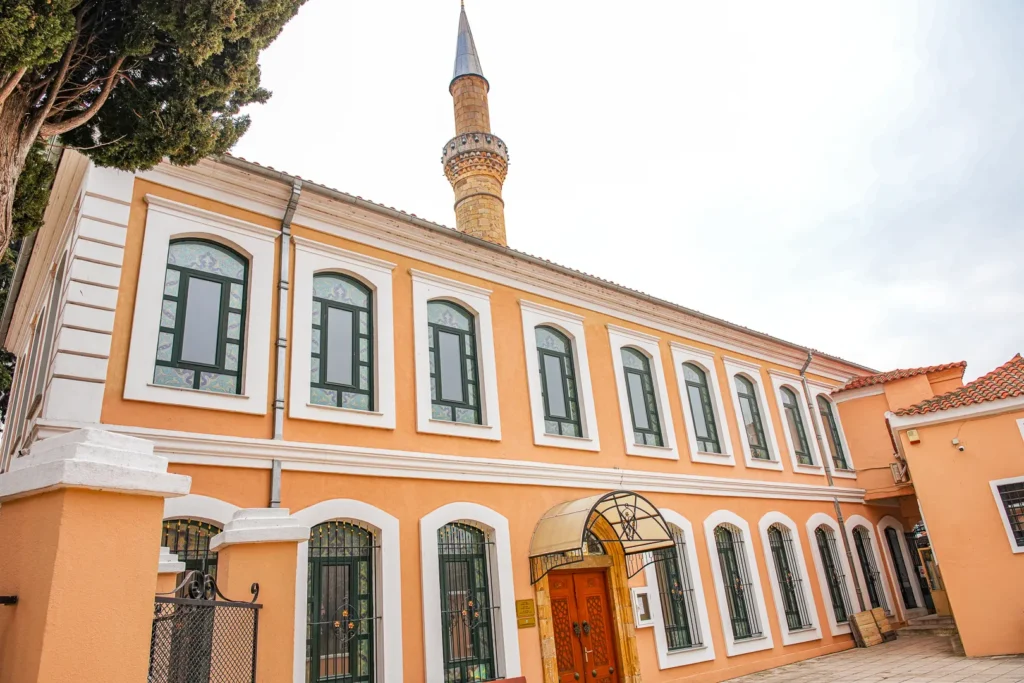
Yeni Mosque
The Yeni Mosque, one of the most iconic landmarks of Komotini and an outstanding example of Ottoman architecture, was built in 1900 and remains an active Muslim place of worship to this day. Known for its impressive form, minaret, and beautiful decorations, the mosque reflects elements of Ottoman artistry. The Yeni Mosque serves as a cultural focal point for the local community and visitors alike, with its cultural significance highlighted by its rich history and architectural heritage.
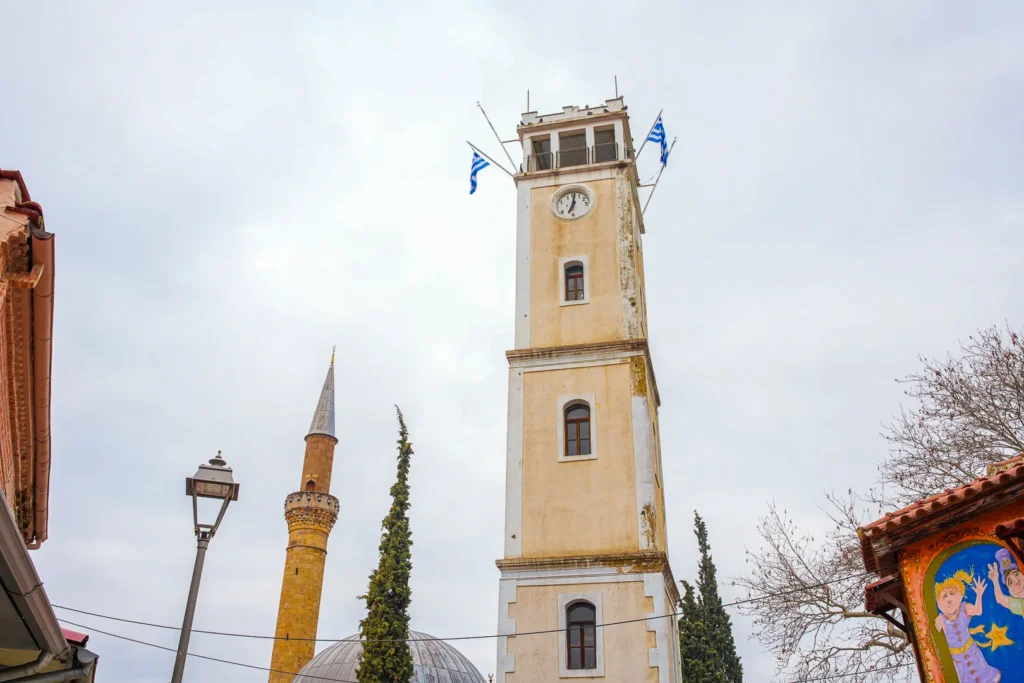
Clock Tower
The Clock Tower of Komotini is one of the city’s most emblematic monuments and a valuable cultural treasure. Constructed in the 19th century, the tower is renowned for its clock, which once provided accurate time to residents and served as a city landmark. The tower’s architecture blends Eastern and Western artistic elements, capturing the region’s cultural diversity. Today, the Clock Tower is not only a popular tourist attraction but also a venue for cultural events, blending Komotini’s history with modern life. Easily accessible, the tower offers visitors a chance to enjoy a panoramic view of the city from above, creating a unique experience that links history with everyday life.
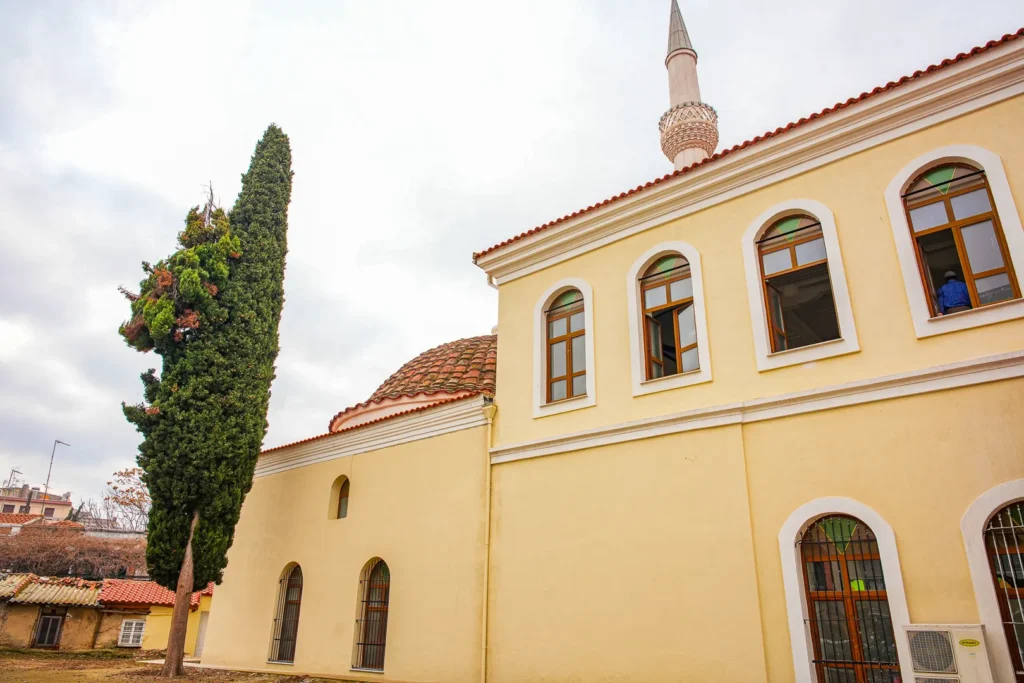
Eski Mosque
The Eski Mosque is one of Komotini’s most significant cultural heritage monuments, representing the area’s history and architecture. Built in 1796, the mosque stands out for its architecture, which combines Ottoman style with local traditions, including its distinctive minaret. Inside, it features beautiful wall paintings and decorative elements, enhancing its artistic value. Today, the Eski Mosque functions as a cultural center and event venue, attracting visitors interested in the history and art of the region. Through exhibitions and activities, it contributes to preserving the memory and identity of Komotini, serving as a bridge between the past and the present.
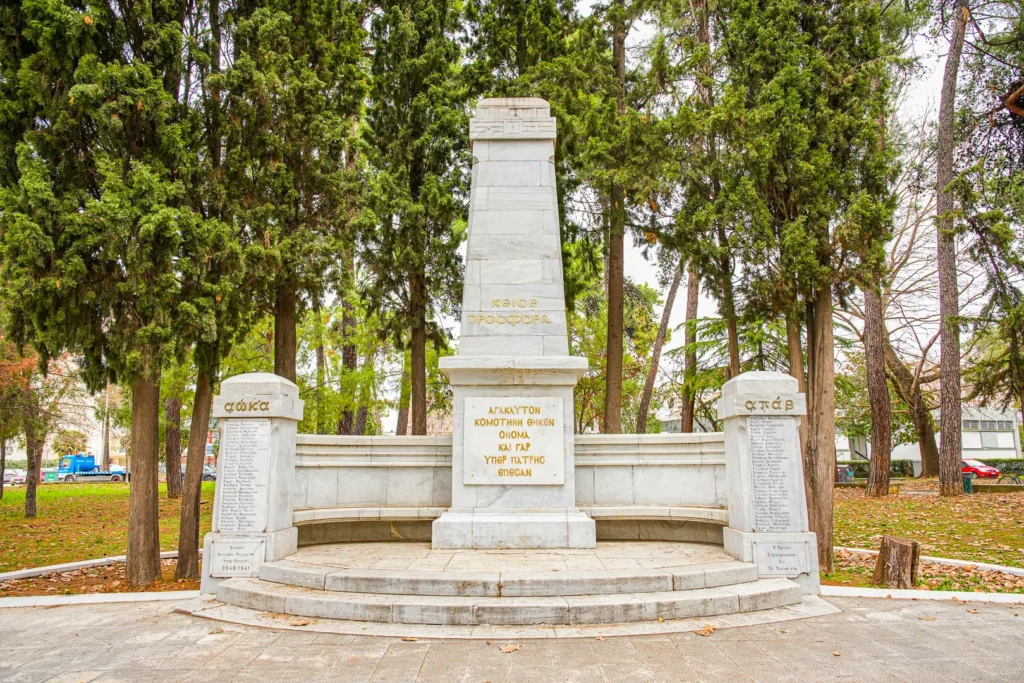
Old Memorial
The Old Memorial of Komotini is a significant monument honoring those who fell during the Balkan Wars and World War I. Located in the city’s central square and constructed in 1928 from white marble, the memorial is adorned with statues and inscriptions depicting soldiers, along with the names of heroes who lost their lives defending their homeland. The surrounding area of the Memorial is often used for national commemorations and local events, strengthening the community’s connection to its historical heritage.
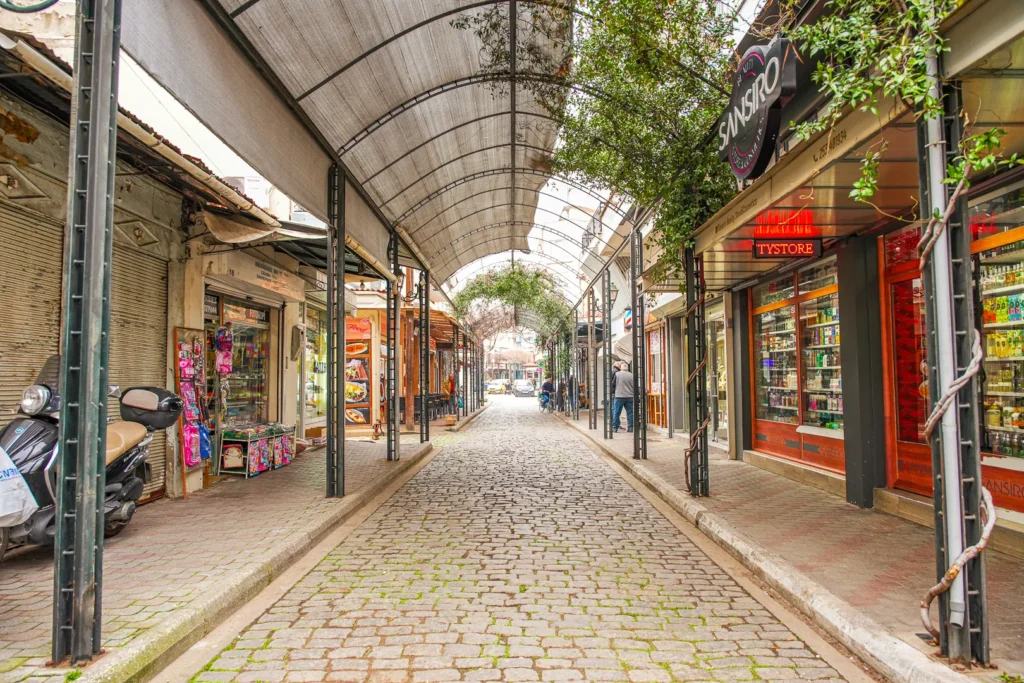
The Old Market of Komotini
The old market of Komotini, with roots dating back to the Ottoman era, is an integral part of the city’s cultural heritage. Located in Komotini’s historic center, its architecture creates a picturesque atmosphere with narrow streets and pergolas. Visitors to the market will find a variety of shops, ranging from antique stores and local product vendors to tavernas offering traditional flavors. This area serves not only as a commercial hub but also as a meeting point for locals and visitors seeking authentic experiences and a taste of the local culture.

Macedonian Tomb of Symbola
The Macedonian Tomb of Symbola is situated approximately 6 kilometers northwest of Komotini, near the village of Symbola, and dates back to the 4th to early 3rd century BCE. The tomb is underground and built with a corridor, an antechamber, and a main chamber, covered by an earthen mound that has been almost leveled due to agricultural activities. It was discovered in 1976 during an illicit excavation that caused damage to the site. Subsequent excavations revealed that the tomb had been looted in the past. Today, the monument is protected by fencing and a shelter, with preservation work completed to ensure its continued protection.

Byzantine Fortress of Nymfea
The Byzantine Fortress of Nymfea, located near the village of Nymfea, is a fascinating historical monument with rich cultural heritage. Its strategic location provided protection for the area during the Byzantine period. The fortress combines elements from various architectural eras, featuring characteristics of both Byzantine and Renaissance architecture. Today, visitors have the opportunity to explore the fortress’s local history, which bears witness to the region’s historical journey.

Medieval Bridge of Kompsatos River
The medieval bridge over the Kompsatos River is located near the river’s outlet, which originates in the Rhodope Mountains, crosses the Thracian plain, and flows into Lake Vistonida. The area surrounding the bridge has a rich history and includes numerous archaeological finds. This three-arched bridge has two piers and two abutments, oriented from west to east. Currently, the middle and eastern arches, as well as the eastern abutment, have been preserved. The bridge is believed to have been built by craftsmen from Epirus in the 17th–18th centuries, with distinctive features such as relief openings with flat bases and arched ceilings, showcasing the architectural skill of the era.

Maximianopolis – Mosynopolis
This is a significant archaeological site located 7 kilometers west of Komotini, near the village of Mishos. Originally, the area was home to the ancient city of Pesoula, but later, Maximianopolis was established, which became known as Mosynopolis during the late Roman period. Excavations at the site have revealed the ruins of a central-plan church, sections of the walls, and box-shaped tombs, with findings from these excavations housed at the Archaeological Museum of Komotini. The city held strategic importance due to its location on the ancient Via Egnatia and served as a center of military activity referenced in many historical periods. However, from the 13th century, it began to decline, leading its inhabitants to relocate to the area of present-day Komotini.

Anastasiopolis – Peritheorion
South of the provincial road between Xanthi and Komotini, near Lake Vistonida, the ruins of a fortified city known to travelers during the Ottoman era as “Bourou Kale” are preserved. This historical area is identified with the ancient city of Anastasiopolis, which was later renamed Peritheorion. The historian Procopius describes it as an important Byzantine settlement, fortified by Emperor Anastasius I. Emperor Justinian I contributed to strengthening the city’s defenses by constructing walls to control the Via Egnatia. The bishopric of Anastasiopolis was subordinate to the metropolitan see of Trajanopolis, and the region holds strategic significance in the history of Thrace. Today, despite the fill and vegetation, the impressive walls of the city still maintain their majestic presence, reminding visitors of the rich heritage of the area.

Archaeological Site of Maroneia
The Archaeological Site of Maroneia, located a few kilometers outside Komotini, is one of the most significant archaeological sites in Thrace, revealing aspects of the ancient history of the region. Founded in the 7th century BC, Maroneia was a flourishing city in antiquity, with great commercial and cultural importance due to its strategic location near the sea and fertile plains. The site features monuments such as the ancient theater, city walls, and the ruins of houses and public buildings, which testify to the social and economic life of its inhabitants. The theater of Maroneia, with its remarkable acoustics and grandeur, still hosts cultural events, connecting the past with the present. Visiting the site offers a unique experience that combines the beauty of the landscape with the historical heritage, making Maroneia an unforgettable destination for any visitor.

Port of Saint Charalambos in Maroneia
Saint Charalambos, the picturesque harbor of Maroneia, is located just 4 kilometers south of the main settlement and represents a unique blend of history and natural beauty. Within the harbor, one can distinguish the ancient sheltered mole, which reflects the area’s significant maritime history. Scattered around the harbor, Roman and Byzantine ruins are visible, enhancing the charm of the landscape and adding archaeological interest, as ongoing research and restoration efforts continue. Visitors can enjoy fresh seafood at the picturesque taverns by the harbor, offering an unforgettable experience thanks to the local hospitality and authentic gastronomy.

Archaeological Site of the Molivotí Peninsula
The Archaeological Site of the Molivotí Peninsula, located near Komotini, is a significant archaeological destination that attests to the rich history of Thrace. This site includes the ruins of the ancient city of Strymi, founded in the 7th century BC by Greek colonists from Thasos, and one of the region’s major commercial hubs. The city appears to have flourished due to its strategic location on the peninsula, offering natural protection from the sea and access to important trade routes. Today, visitors can view the remnants of the city walls, homes, and the ancient harbor, while the breathtaking view of the Thracian Sea and the natural landscape of the peninsula complement the experience. The site offers a unique combination of historical and natural beauty, inviting visitors to explore a piece of the area’s ancient heritage.

Staliou Mansion
Staliou Mansion in Komotini is one of the most important preserved buildings in the city, reflecting the rich history and architecture of Thrace. Built in the late 19th century, the mansion showcases the influence of neoclassical architecture, blending elegance with traditional Thracian aesthetics. The residence originally belonged to the Staliou family, one of the most prominent families in the area, and today it retains its original decoration and grandeur. A visit to the Staliou Mansion offers the opportunity to explore not only the cultural heritage of Komotini but also to appreciate the distinctive architecture that makes it one of the most attractive historical sites in the region.
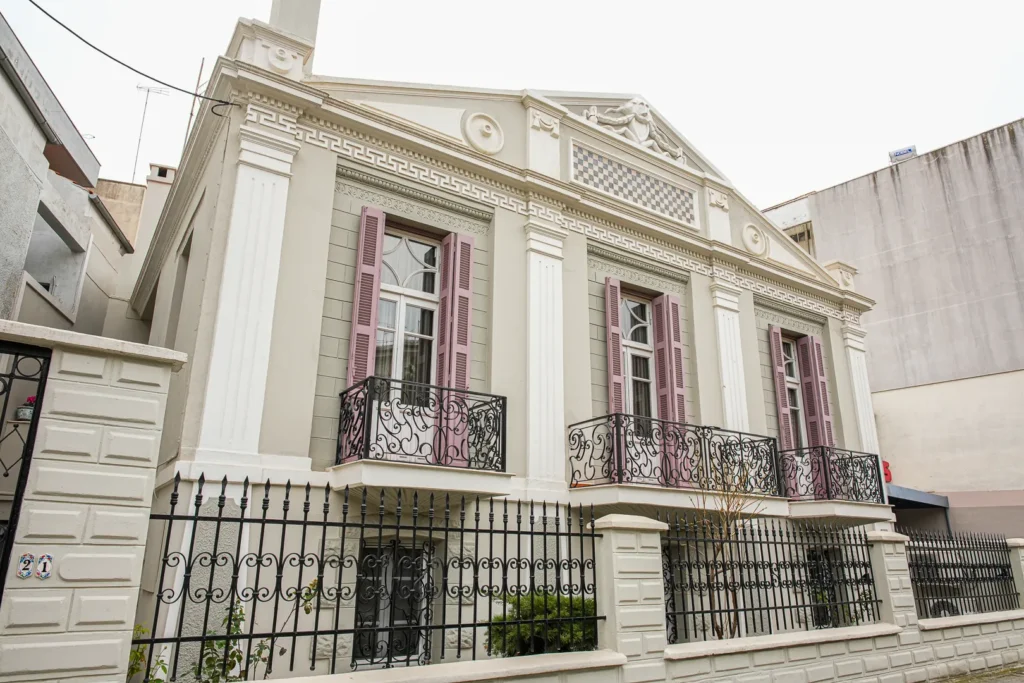
Dermetzoglou Mansion
Dermetzoglou Mansion, one of the most characteristic examples of Komotini’s architecture, highlights the region’s rich cultural heritage. Built in the mid-19th century, the mansion belonged to the Dermetzoglou family, which had significant influence on the city’s economic and social life. The architecture of the building features elements of neoclassicism, with impressive balconies, intricate wood carvings, and mosaic decorations that reflect the art and craftsmanship of the era. Today, the building hosts cultural events and activities, becoming a focal point for both locals and visitors to Komotini, who wish to explore the area’s history and traditions.
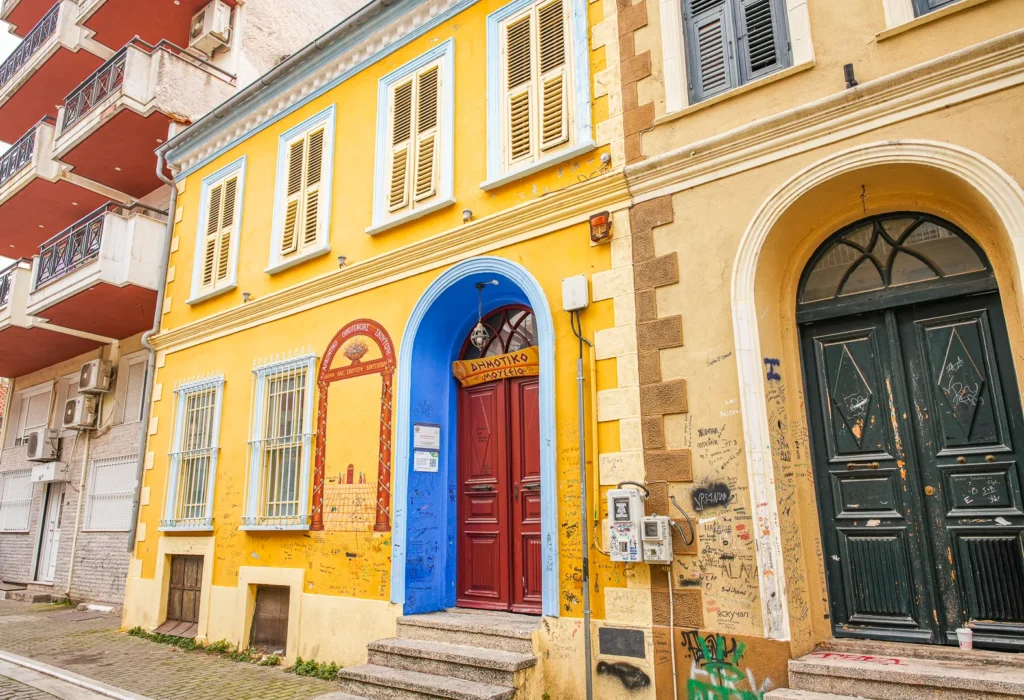
Lysandros Skouteris Mansion
The Lysandros Skouteris Mansion, located in Komotini, is an exceptional example of Ottoman-period architecture with significant historical value. Built in the late 19th century, the building combines elements of traditional Byzantine and Ottoman architecture, featuring intricate woodwork and rich decorations. Today, the mansion has been renovated and functions as a cultural space, offering visitors the opportunity to explore the history and cultural heritage of the region. Regular guided tours reveal its historical aspects, while events are held that promote local art and tradition.
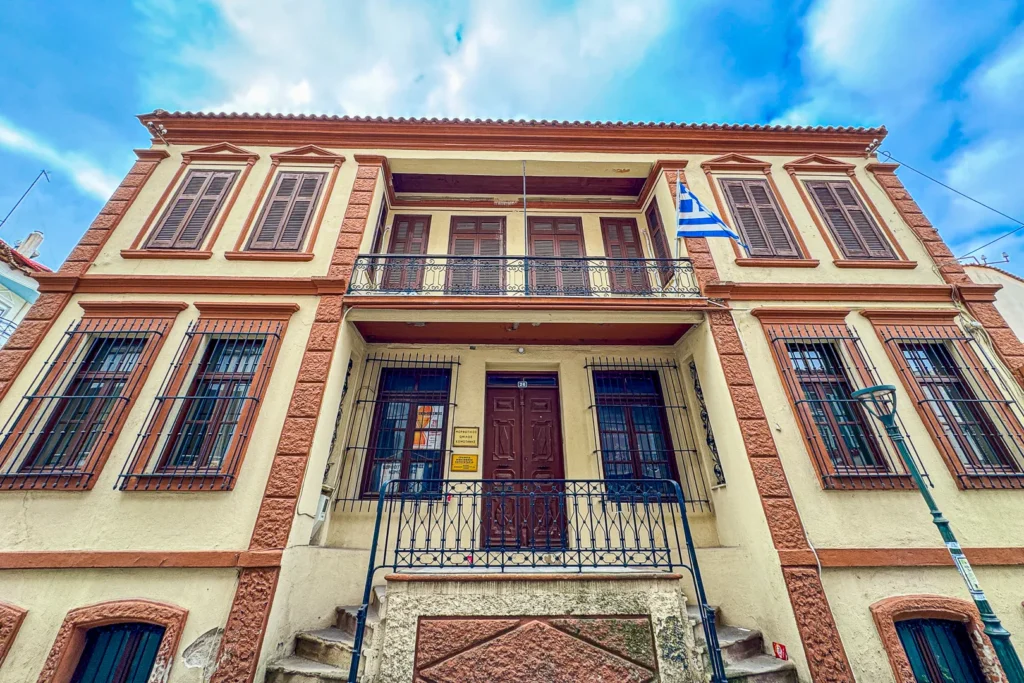
Peidou Mansion (Cultural Club of Komotini)
The Peidou Mansion is an important monument of Greek folk architecture in Thrace, classified as an artwork requiring special state protection under Law 1469/50. Today, it belongs to the Cultural Club of Komotini and is one of the few traditional buildings preserved in the city. The interior hosts the Folk Museum, which has been operating since 1962, showcasing the region’s rich cultural heritage. Visitors can explore the folk art and traditions of Thrace through a variety of exhibits, offering a unique glimpse into the area’s past.
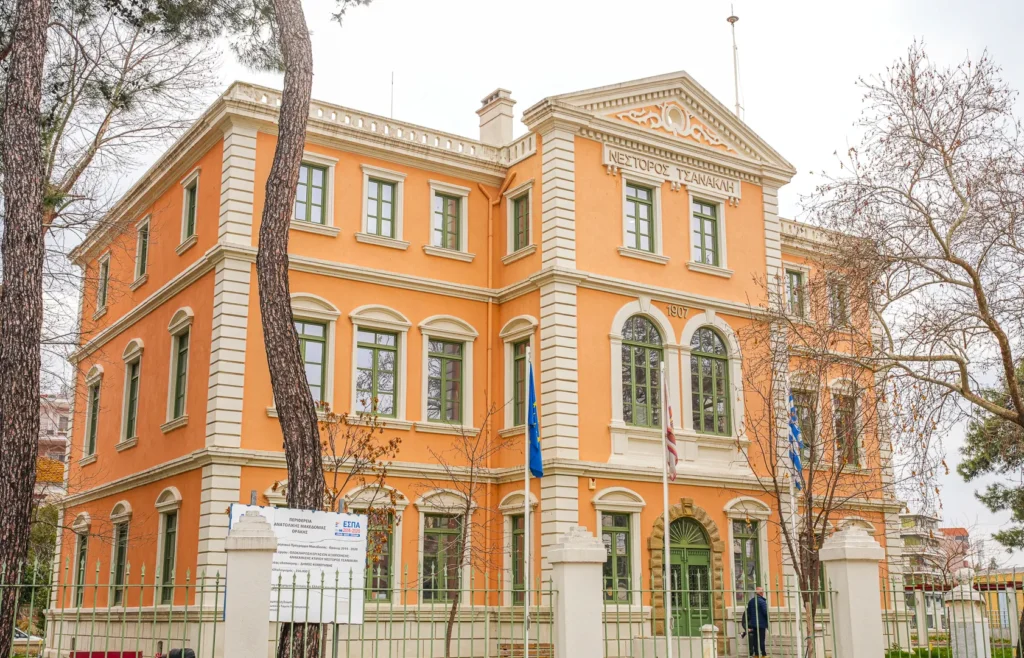
Tsanakli Mansion (Mansion of the Greek Urban School)
The Tsanakli Mansion, also known as the Mansion of the Greek Urban School, is an important example of eclectic architecture and a historical monument in the region. Built between 1906 and 1907 with funding from Nestor Tsanakli, a major tobacco merchant and philanthropist, the building originally served as the Male Urban School. Later, it housed various public services such as an orphanage and the General Administration of Thrace. In recent years, the mansion has been renovated to highlight its cultural heritage, returning to the citizens of Rodopi. It is recognized as one of the few traditional buildings preserved in Komotini. The history and architecture of the building are a significant reference for the local community and the culture of the region.
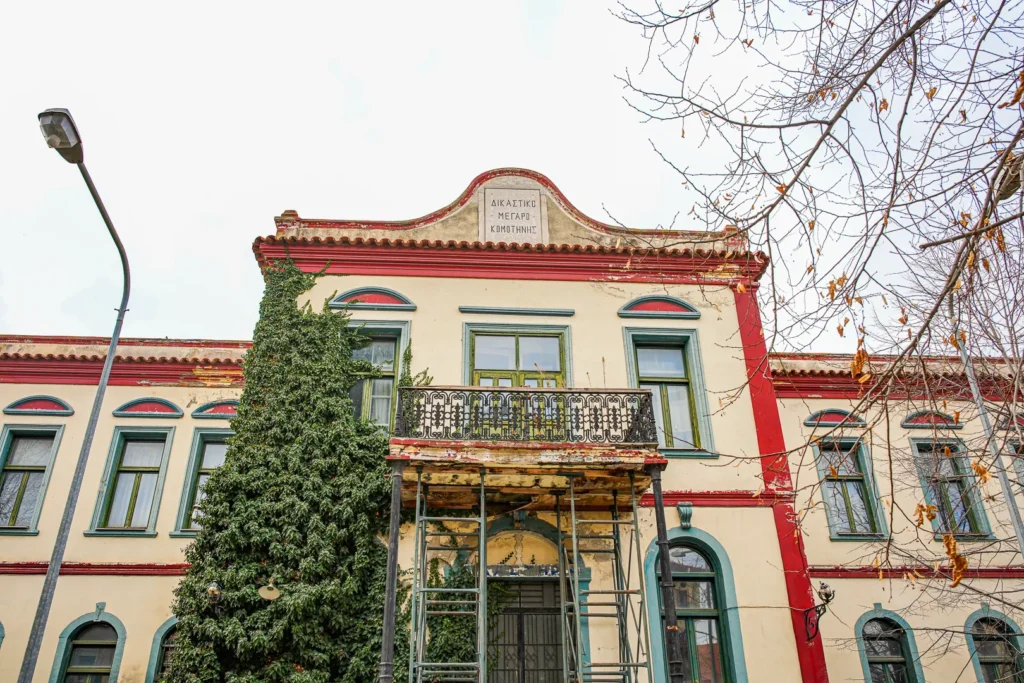
Old Courthouse of Komotini
The Old Courthouse of Komotini is one of the most iconic buildings in the city, with a history spanning from the Ottoman period to the modern era. Built in 1870, it initially served as the administrative center of the Ottoman state when Komotini was the administrative hub of Adrianople. The building combines features of Ottoman architecture, such as the elevated basement and two floors, and also includes a prayer space (mescit). After the liberation of Komotini in 1920, the building became the headquarters of the Thracian administration and later functioned as a courthouse until 2004, when the services were relocated to a new building.

Building of the Old Division and the Two-Story Auxiliary Building
The building of the Old Division in Komotini has a rich history closely connected with the military presence in the region since the Ottoman era. Constructed as a strategic center, it housed the 12th Division from 1913, the year the city was liberated. This division played a significant role during the Balkan Wars and the Bulgarian occupation, serving as the administrative center for military forces. Next to the main building, the two-story auxiliary building provided additional space for administrative and support functions. Today, the building is recognized for its architectural value and its importance in the region’s cultural heritage, serving as a point of reference for visitors who wish to explore the history of Komotini and Thrace.

House at 15 Tsanakli Street
The house at 15 Tsanakli Street in Komotini is a characteristic example of neoclassical architecture, recognized as an artwork with special state protection. The two-story building features impressive decorative elements, such as pseudo-columns ending in Corinthian capitals, and rich decorative framing around its openings. In the past, it housed the Municipal Library, and today it hosts the company K. Karatheodori S.A. The Tsanakli Street area is known for its rich architectural heritage, containing other neoclassical buildings that form an important historical core in Komotini. The preservation of this building highlights the city’s cultural identity and the need to protect its architectural heritage.
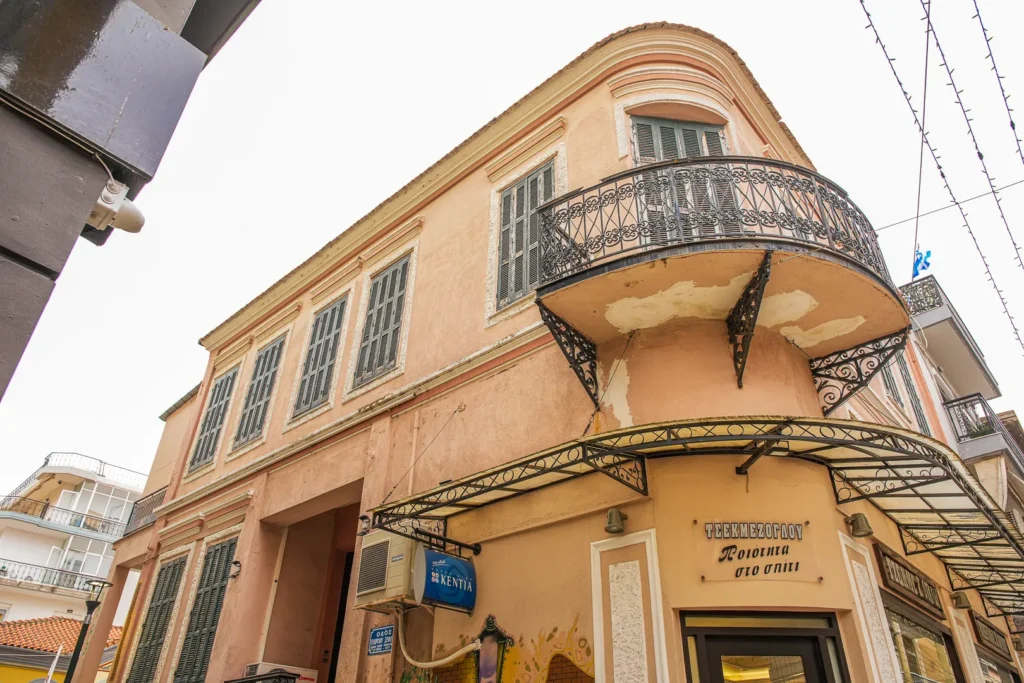
Building at 10 Venizelou Street
The building at 10 Venizelou Street, owned by Theologos, is designated as a historic listed monument and a work of art, requiring special state protection. This building is a significant example of the architectural heritage of the region, featuring rich architectural and morphological elements that attest to its artistic value. Its importance is further enhanced by its contribution to the study of architectural history, providing valuable insights into the construction styles of its time. The surrounding space integrates and complements the building’s architecture, making it an important landmark in Komotini and emphasizing the need to protect our cultural heritage.
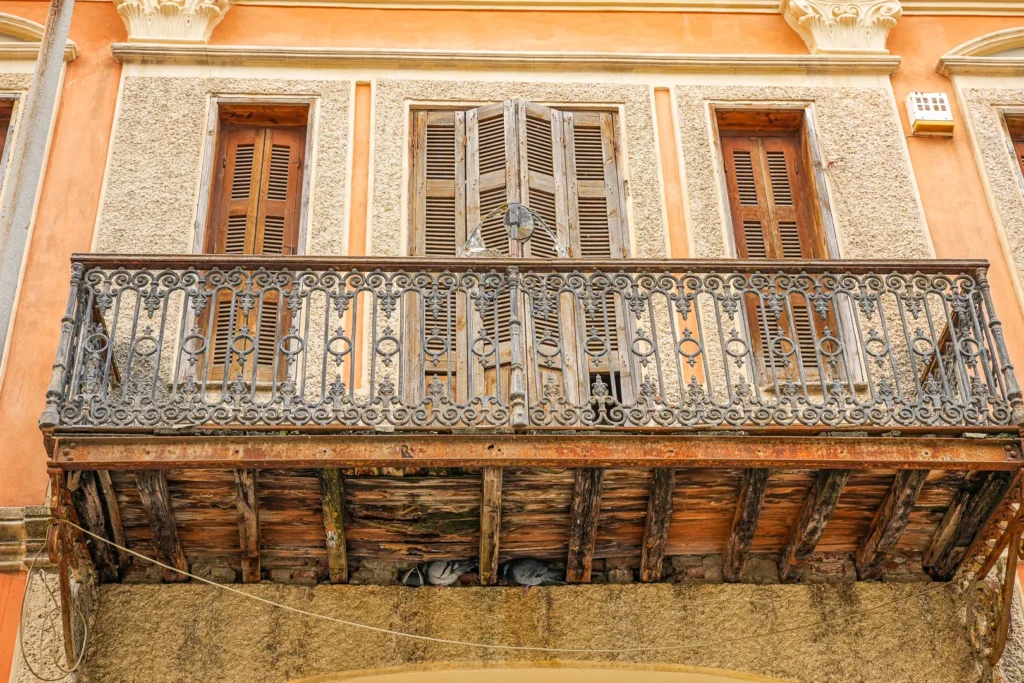
Building at 6 Tsanakli Street (Illiadi Mansion)
The Illiadi Mansion, located at 6 Tsanakli Street, is a notable neoclassical building constructed after 1850, classified as a work of art in need of state protection. It reflects the economic development of the era and the typology of houses built by merchants. The two-story building features symmetrical facades, an internal circular staircase, and a well-crafted balcony with a wrought-iron railing. Special attention should be given to the decoration of the windows and the details of the central double-leaf door, which contribute to its architectural value.

Building on Ioakeim III Street
The building on Ioakeim III Street, owned by Ant. Georgiou, has been designated as a historic listed monument due to its architectural significance and cultural character. It is one of the notable examples of popular urban housing from the early 20th century and holds importance in the study of architectural history. The architecture of the building reflects the cultural trends of its time, incorporating elements that highlight the local tradition and urban life of Komotini.
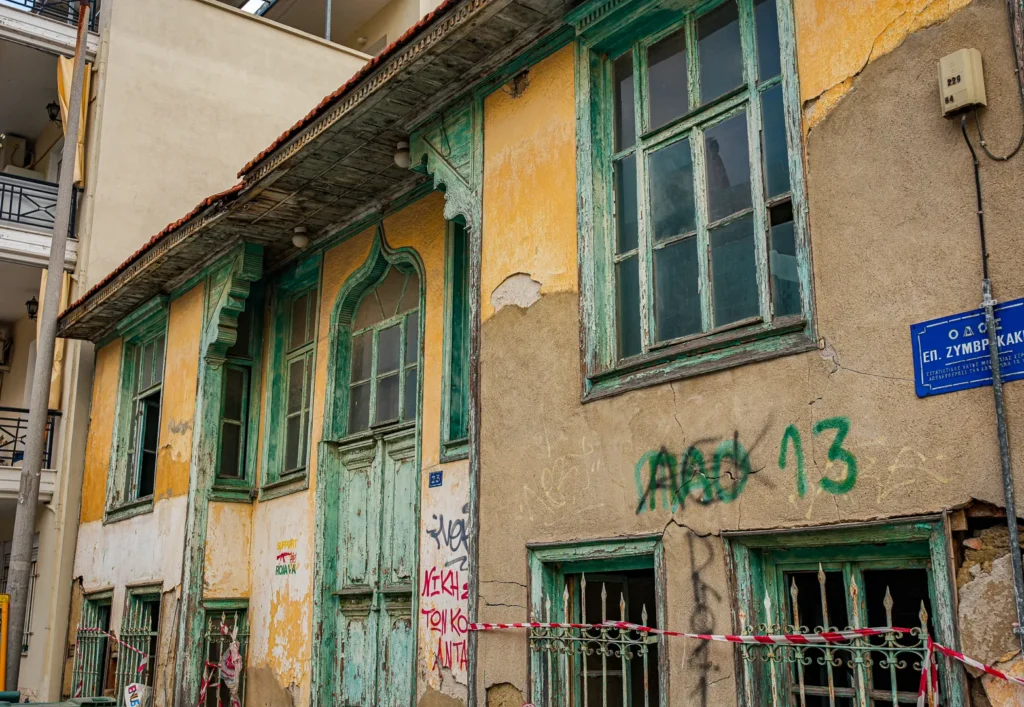
Building at 25 Zymvrakaki Street
The building at 25 Zymvrakaki Street has been designated as a historic listed monument and a work of art that requires special state protection. This recognition is due to the fact that the building is an important example of the region’s architectural heritage, with interesting construction and morphological elements reflecting local architecture. Moreover, the building serves as an important source for the study of architectural history, showcasing the cultural and historical values preserved in Komotini. With its surrounding space, the monument enhances the cultural identity of the area, offering visitors a unique sense of the past.
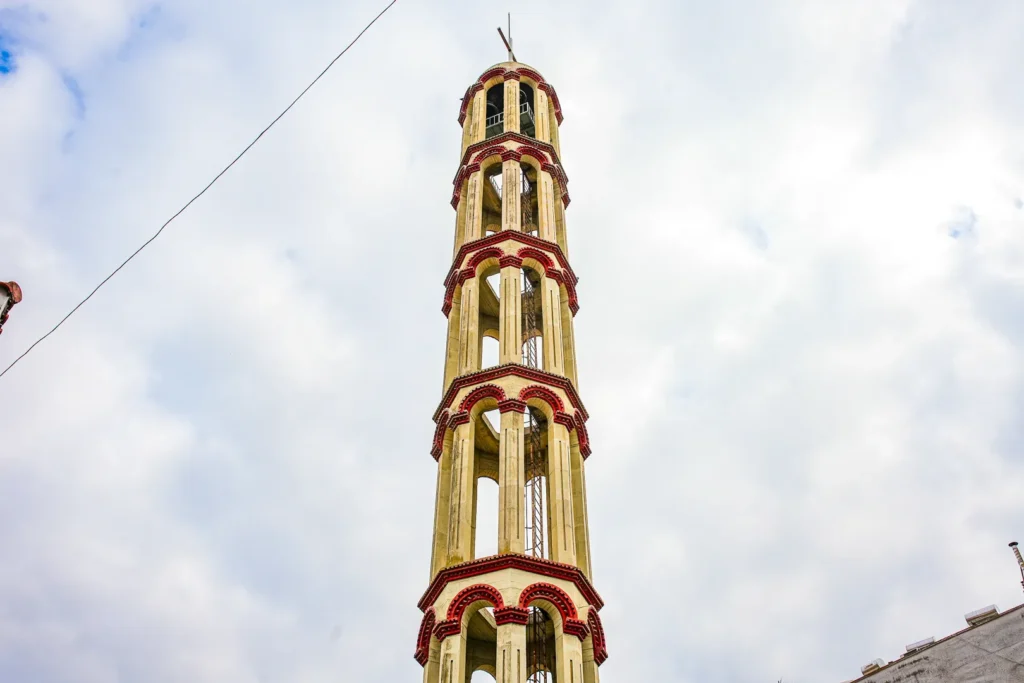
Building at Saint George and ChatzikonstantisZoidis Streets
The building located at the intersection of Saint George and ChatzikonstantisZoidis Streets, owned by the Ioannidis brothers and the Municipality of Komotini, is classified as a historic listed monument and a work of art, requiring special state protection under Law 1469/50. This building is an important example of the region’s architectural heritage, combining elements of both local and urban architecture. Its significance is especially notable for the study of architectural history, as it houses the Thracian Museum of Education, which contributes to showcasing the cultural heritage and educational history of Thrace.
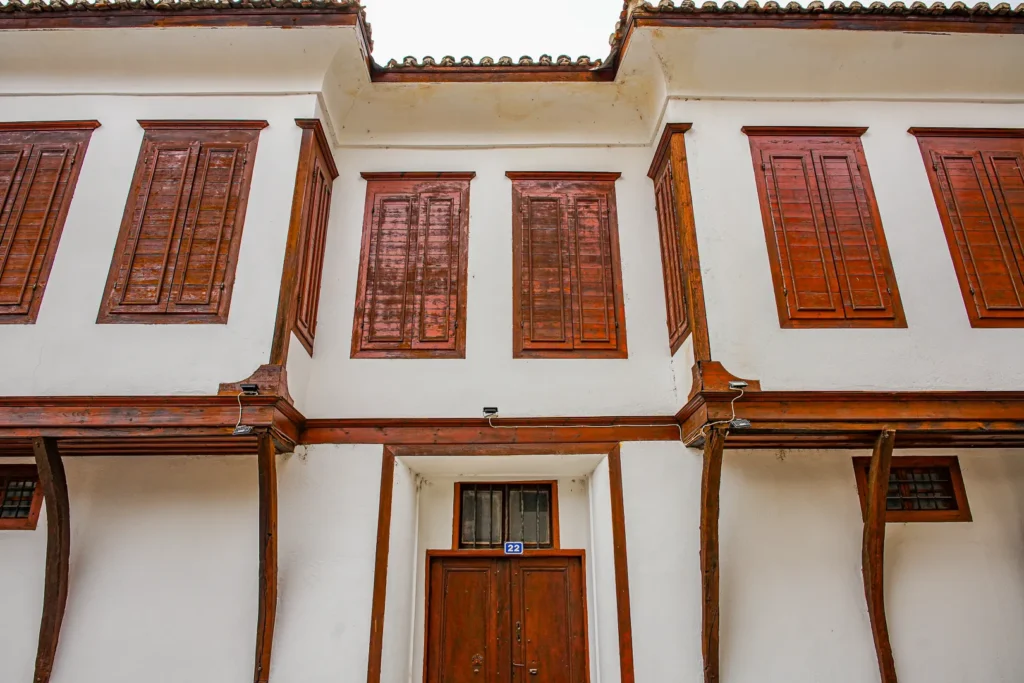
Building at 22 Saint George Street
The building at 22 Saint George Street is designated as a historic listed monument and a work of art requiring special state protection under Law 1469/50. Owned by the state, it currently hosts the Cultural Society of Komotini and is recognized as a significant neoclassical structure. Located in an area of the city with many important buildings, it adds to the architectural heritage of the region. This designation includes the surrounding space, apart from the later addition, which may be demolished if deemed appropriate and after obtaining a permit from the relevant Urban Planning office. The building is open to visitors by appointment, with information available at the nearby Folk Museum.

Building at 6-8 Kouloglou Street
The neoclassical building at 6-8 Kouloglou Street, owned by Spentopoulos and the Municipality of Komotini, stands out for its architectural beauty and unique design. It consists of a semi-basement, ground floor, and first floor, divided into two identical and equal residences. The main entrances of the residences are adorned with arched lintels and semi-circular skylights, protected by iron bars, adding an air of elegance. The linear cornice separating the ground floor from the upper floor emphasizes the symmetry of the facade, where a series of rectangular windows framed with cornices create a harmonious effect. At the top of the building, an impressive cornice is supported by small brackets, decorated with simple floral motifs, adding a decorative detail that enhances the architectural space.

Building at Kouloglou and Seferis Streets
The building located at the intersection of Kouloglou and Seferis Streets is a historic listed monument, owned by the Municipality of Komotini. Valued for its architectural heritage, the building features rich morphological elements that combine local and urban architectural styles, making it significant for understanding the architectural history of the region. The surrounding area is included within the property boundaries, further adding value to the whole. Today, the building hosts the Cultural Center of the Municipality of Komotini, promoting cultural activities and local art.
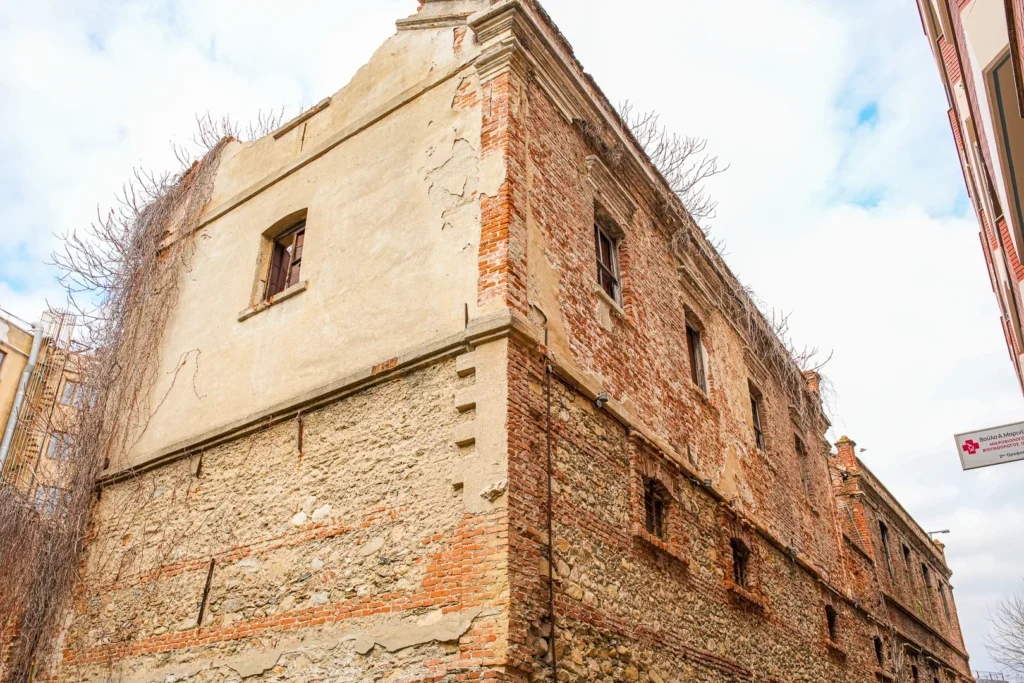
Zoidis Tobacco Warehouse in Komotini’s Central Square
The Zoidis Tobacco Warehouse, one of the most iconic buildings in Komotini, stands in the city’s central square as a significant testament to its industrial heritage. During the peak era of tobacco trade and processing in Eastern Macedonia and Thrace, the warehouse played a crucial role in shaping Komotini’s urban fabric. Despite its considerable historical and cultural value, years of abandonment have distanced it from contemporary relevance.

Tobacco Warehouse on 8 Parnassou Street
The tobacco warehouse at 8 Parnassou Street is designated as a historic listed monument, representing one of the few remaining examples of tobacco warehouses in the city. Its existence highlights the economic growth experienced in the region over the past century and into the early 20th century, when tobacco processing and trade were primary economic drivers in Komotini. With its unique architectural value and historical significance, the building now belongs to the Technical Chamber of Thrace, which undertakes its maintenance and utilization, preserving the memory of the area’s industrial heritage.

Papikion Mountain
Papikion Mountain holds unique religious significance, having served as a center of monastic life since the 11th century, when Byzantine emperors elevated it to an important religious destination. Numerous monasteries and hermitages were established on its slopes, where monks and hermits sought spiritual solitude and prayer. For centuries, Papikion drew both devotees and religious communities, and it is considered one of the first organized monastic centers in Greece, playing a key role in the development of Orthodox monastic tradition.
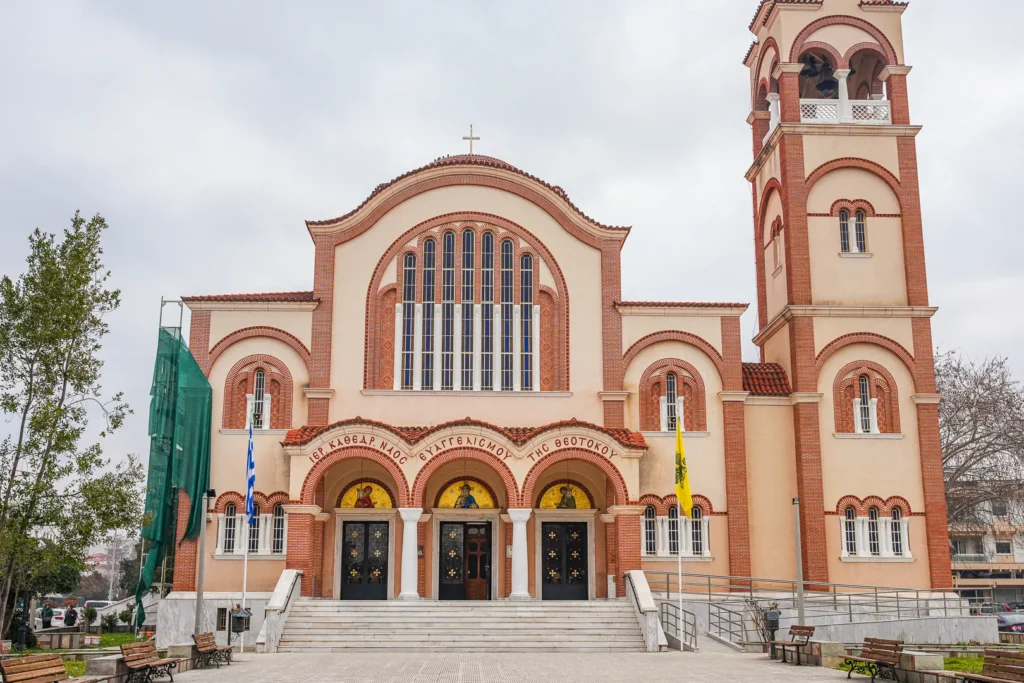
Cathedral of the Annunciation of the Virgin Mary
The Cathedral of the Annunciation of the Virgin Mary is one of Komotini’s most significant religious landmarks, known for its impressive architecture and long history. Constructed between 1902 and 1904, the cathedral showcases Neo-Byzantine style, with beautiful frescoes and iconography decorating its interior. The structure is a three-aisled basilica with a cross-shaped roof and a striking dome, adding to its architectural charm. Situated in the heart of the city, it serves as a focal point for residents and is both a place of worship and cultural interest for visitors. Dedicated to the Annunciation of the Virgin Mary, the cathedral hosts important events during religious holidays, including the major feast on March 25, drawing many worshippers. With its imposing character and distinctive architecture, the cathedral stands as a significant symbol of Komotini’s religious and cultural heritage.
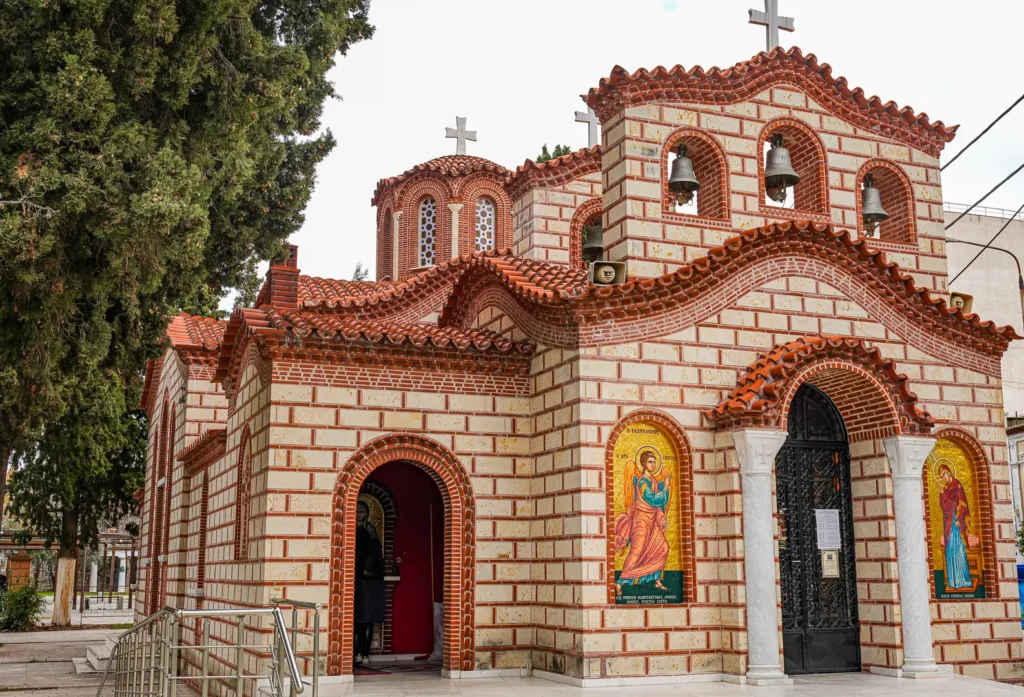
Church of Saint Paraskevi
The Church of Saint Paraskevi is the principal religious and cultural landmark of Komotini, dedicated to the city’s patron saint, Saint Paraskevi. Known for its historical significance, it draws thousands of faithful each year, especially during its celebrations, which feature elaborate services and cultural festivities. The church has undergone multiple expansions and renovations over time, continuously attracting people of all ages and reinforcing local community spirit through faith and tradition. Saint Paraskevi is regarded as the protector of Komotini, with believers leaving offerings and prayers in hopes of her intercession.
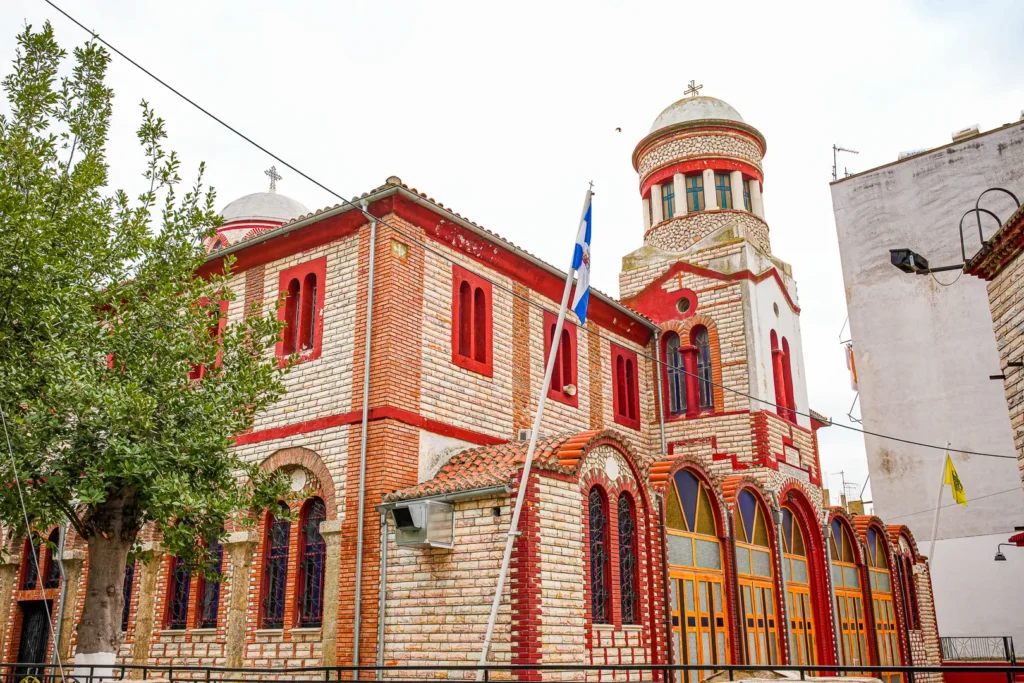
Church of Saint George
The Church of Saint George is one of the region’s most iconic religious monuments, centrally located and easily accessible for both residents and visitors. Dedicated to Saint George, this three-aisled church incorporates Byzantine architectural elements and features striking frescoes depicting scenes from the life of Saint George, creating a deeply spiritual atmosphere. Its location near historic mansions and the Thracian Museum of Education, which is within the church’s courtyard, emphasizes its link to local cultural heritage. Under the administration of the Metropolis of Komotini and Maroneia, the church holds significant spiritual and social value for the local community.

Church of the Dormition of the Virgin Mary in Maroneia
The Church of the Dormition of the Virgin Mary in Maroneia stands as a major religious and cultural site in the region. Built in 1800, it replaced an earlier church mentioned in 16th-century historical records by the French traveler Bellon, who noted its presence amidst the ruins of a small castle. The church has undergone numerous renovations, the most recent in the 1980s. Notable features include its intricately carved wooden iconostasis, dating back to 1741, and its wooden construction, which adds to its unique charm. The discovery of ancient tombstones in the church’s courtyard further highlights the area’s rich historical background.

Holy Monastery of the Entry of the Theotokos in Pandroso
The Holy Monastery of the Entry of the Theotokos, located northeast of Komotini near the village of Pandroso, is a women’s monastery approximately 10 km from the city. Founded with the blessing of the late Archpriest Michael Ignataki and approved by the late Metropolitan of Maroneia and Komotini, Damaskinos, the monastery also received support from Saint Paisios of Mount Athos. In 1997, a 10-acre plot was donated by the Eastern Macedonia and Thrace Region for its construction, with the first section of the northern wing built in 1998 and completed in 2001. This section includes large halls, a kitchen, and cells for nuns and guests. With the completion of these facilities, the first nun settled in the monastery, and in 2005, Sister Ioanna took on the role of abbess.

Holy Monastery of the Virgin Mary Faneromeni of Vathyriako
Near the village of Aigeiros, the Holy Monastery of the Virgin Mary FaneromeniVathyriakos is a significant religious site in Thrace. Founded in 1930, it is associated with the discovery of a miraculous icon of the Virgin Mary found during the Ottoman period. Over the years, the monastery has become a pilgrimage destination, drawing a large number of faithful. Its architecture combines traditional and modern elements, and the spiritual life within the monastery is enriched by the monks’ activities and the pilgrims’ prayers.

Holy Monastery of Saint Maximos Kausokalyvos
The Holy Monastery of Saint Maximos Kausokalyvos, located on Mount Papikion, is one of the most significant monastic centers in the region. Founded to promote monastic life and spiritual quest, it reflects the deep faith and traditions of Orthodox Christianity. Dedicated to Saint Maximos, the monastery has been restored and now operates actively, offering opportunities for worship and spiritual guidance. Since August 2023, a permanent hieromonk resides in the monastery, performing daily services and preserving monastic traditions, providing spiritual support to visitors and the faithful.
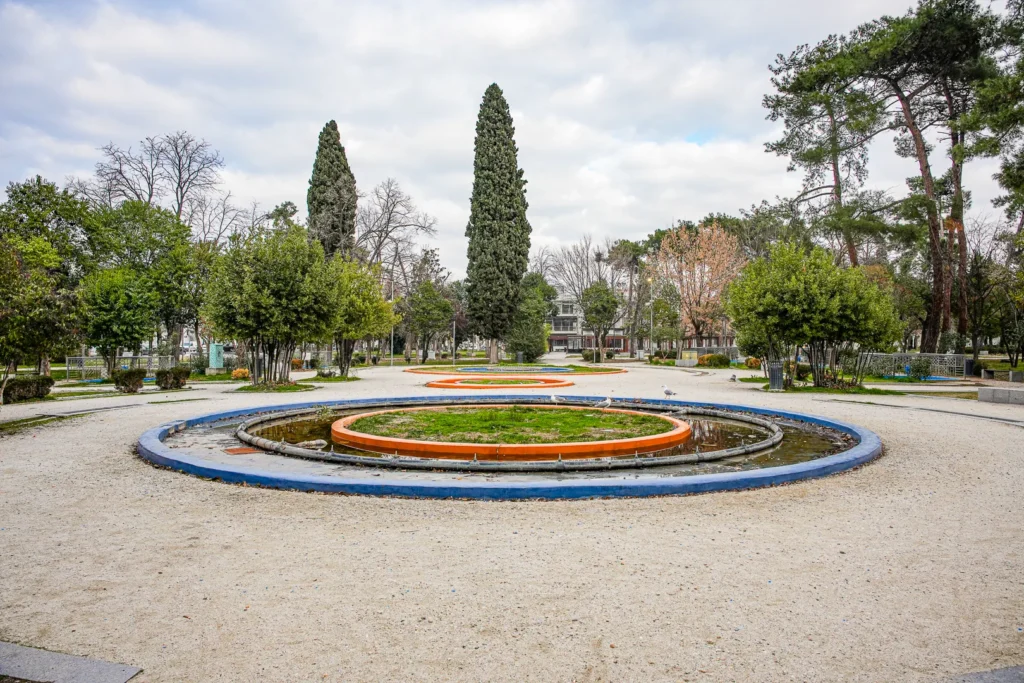
Saint Paraskevi Park
Saint Paraskevi Park in Komotini is one of the city’s most beloved green spaces, providing residents and visitors with a tranquil retreat in nature. Located near the city center and easily accessible, it is an ideal spot for family outings, picnics, or simply relaxing. The park features well-maintained paths, lush vegetation, and playgrounds, catering to both children and adults. With various seating areas and recreational corners, Saint Paraskevi Park enhances the sense of community and social interaction, making it a vital gathering and leisure space in Komotini.

Cyclops Polyphemus Cave
Located near Komotini, the Cyclops Polyphemus Cave is one of the region’s most impressive natural attractions, with a name that evokes mythological ties, although the Cyclops Polyphemus is more traditionally associated with Ithaca and Homer’s Odyssey. This cave is renowned for its stunning stalactites and stalagmites, formed over centuries, offering a fascinating exploration opportunity for visitors. The surrounding natural landscape enhances the experience, attracting nature and history enthusiasts to explore its beauty and learn about the Thracian heritage that permeates the area.

Strymi Cave Complex
At the northeastern slopes of Mount Ismaros, near the village of Dioni, lies the Strymi Gorge, home to the Strymi Cave Complex. Comprising three main caves and several rock shelters, the complex lacks stalactite and stalagmite formations but holds significant archaeological interest. Excavations have shown that two of these caves were used as habitation sites, likely during the Late Neolithic period and Early Bronze Age, with evidence of use also during the Byzantine period. These findings highlight the historical significance of the area and link it to key time periods in the region’s past.

Old Mill &Mishos Waterfall
In the village of Mishos near Komotini, visitors can enjoy the scenic waterfall and traditional watermill, a unique blend of natural beauty and cultural heritage. Although artificial, the waterfall adds tranquility to the landscape, while the old mill stands as a reminder of the area’s history and traditional production techniques. Ideal for hiking, the site offers trails through lush greenery and water springs, making it a popular destination for nature lovers seeking relaxation, and for those interested in exploring the history and culture of Thrace.

Nymfaia Forest
Nymfaia Forest is a natural haven near Komotini, offering a rich experience in the heart of nature. This forest spans an area of dense vegetation, primarily consisting of pines and oaks, with numerous hiking and biking trails that provide access to its most scenic spots. At the heart of the forest lies the traditional settlement of Nymfaia, known for its stone-built houses and panoramic views. The forest attracts nature lovers and hikers who enjoy the fresh air, landscapes, and the serenity it offers. Additionally, Nymfaia Forest is home to a diverse flora and fauna, making it an essential ecosystem for the wider region.

Symbola Waterfalls
The Symbola Waterfalls are a hidden natural gem, offering visitors a unique experience in the heart of nature. Located about 20 kilometers west of Komotini in the mountainous Rhodope region near the village of Iasmos, the waterfalls are accessible by a scenic trail that winds through dense vegetation, featuring beech trees, plane trees, and the region’s wild flora. The waterfalls create small natural pools, where visitors often pause to enjoy the refreshing atmosphere and beauty of the landscape. This area is ideal for hiking, photography, and quiet retreats away from city life. The Symbola Waterfalls attract visitors year-round, showcasing different colors and scenes with each season, making it a beloved spot for nature enthusiasts.

Ismarida Lake
Ismarida Lake is one of the most significant natural lagoons in the area and plays a crucial role in the biodiversity of Thrace. Spanning approximately 1,500 hectares, the lake is home to a variety of waterfowl, making it a prime destination for birdwatchers. The lake is surrounded by lush vegetation, and its waters are primarily fed by the Kompsatos River. Besides its natural beauty, Ismarida Lake offers recreational opportunities such as hiking and boat rides, attracting visitors eager to explore its unique ecology. The lake is also vital for local communities, providing water resources and supporting agricultural production in the region.

Xirolimni Lagoon
Xirolimni Lagoon is a unique wetland ecosystem known for its rich biodiversity. It hosts an array of bird species, including pelicans and cormorants, making it a popular destination for birdwatchers and nature lovers. The lagoon is deeply intertwined with the local history and culture, as residents have traditionally utilized it for fishing and farming. The stunning landscape of Xirolimni offers opportunities for recreation and peaceful nature excursions. Protecting this ecosystem is essential, as it contributes to environmental balance and the well-being of the local community.

Karatzas Lagoon
Karatzas Lagoon is one of the most significant wetlands in the region, known for its rich biodiversity and stunning natural beauty. This extensive lagoon serves as a sanctuary for numerous bird species, especially during migration periods, offering visitors exceptional bird-watching opportunities. The surrounding area is rich in plant life, providing an ideal environment for the development of various ecosystems, making it a must-see spot for nature enthusiasts.

Aliki Lagoon
Aliki Lagoon is a unique wetland rich in both flora and fauna. It is part of the Natura 2000 network, providing a safe haven for rare and endangered marine species and a diverse array of birdlife, making it an important destination for birdwatchers and nature lovers alike. In addition to its ecological value, the lagoon offers many recreational activities, such as hiking and biking along scenic trails, making it a delightful destination for those who wish to explore the natural beauty of the area.

Ptelea Lake
Ptelea Lake is an artificial lake created in 1980 to support irrigation and water storage for surrounding agricultural lands. This reservoir has fostered a thriving ecosystem, hosting a variety of bird species, including pelicans, and has become a popular site for bird-watching and ecotourism. The surrounding area offers opportunities for hiking, biking, and outdoor activities, drawing visitors who want to immerse themselves in the natural charm and tranquility of the region.

Elos Lagoon
Elos Lagoon, the easternmost lagoon of the Rhodope region, spans 2,460 hectares and is notable for its rich birdlife, hosting numerous species year-round. The area is surrounded by diverse habitats, including salt marshes and beaches, and is home to large populations of flamingos, mute swans, as well as rare plants and fish. It is a vital ecosystem that contributes to the ecological balance of the region, making it a valuable site for wildlife observation and conservation.

Papikio Mountain
Papikio Mountain is a key natural attraction in the region, reaching an elevation of 1,577 meters and offering breathtaking views alongside a rich biodiversity that includes rare plants and protected animal species. The mountain is traversed by hiking trails that wind through lush forests, inviting nature enthusiasts to explore and enjoy recreational activities in an unspoiled environment. Papikio is steeped in local myths and traditions, giving visitors a chance to experience both its natural beauty and its cultural heritage. It’s an ideal destination for those who love nature and adventure, blending scenic exploration with a sense of historical intrigue.

Lake Vistonida
Lake Vistonida spans 42,000 acres and is surrounded by extensive wetlands that support rare plant species such as water lentils and water chestnuts. A unique feature of Vistonida is its variable salinity levels: the northern part of the lake contains freshwater from three rivers, while the southern section is brackish, receiving seawater through connecting channels. These conditions create a rich habitat for numerous bird species, including herons, cormorants, and rarer birds like the slender-billed curlew and the lesser white-fronted goose. Especially in spring and autumn, migratory waterbirds and waders populate the lake, making it a crucial stopover site. The lake’s reed beds and lakeside forests are home to endangered species like the glossy ibis and the ferruginous duck, marking Lake Vistonida as an invaluable natural treasure and an important ecosystem in the region.

Kompsatos River Habitat
The habitat surrounding the Kompsatos River is an ecologically rich area with high biodiversity. Originating from the Rhodope Mountains and flowing into Lake Vistonida, the river supports a range of rare flora and fauna, including birds of prey that find refuge in its landscape. This area is internationally protected under agreements such as the Ramsar Convention and the Natura 2000 and CORINE programs, highlighting its importance in preserving ecological balance within Greece. The Kompsatos River habitat is a vital area for conservation, contributing significantly to the environmental health of the region.
